We can bet that every time you hear about a plane having crashed, you shudder. Many people have fear of flights and height, and flying on a plane takes its toll on them. They get panicky very quickly and shake or behave uncontrollably. Yet, the chances for a plane to crash are very low. 1 out of 9 million planes will crash, according to statistics. In fact, driving a car is many times more dangerous and results in thousands of victims daily in any country in the world.
[the_ad_placement id=”in-text-1-type-r”]Another thing to note is that there are almost always survivors in 95% of all cases. This means that there are ways to protect yourself and survive the plane crash. If you learn these techniques and tips, and you stay alert (but not nervous) during the flight and are always aware of the situation and any changes, you have very high chances of surviving.
Of course, there are many other things you need to be aware of, and we will talk about them in this article. So read on and learn how to survive a plane crash.
Here is what to do to survive the plane crash
Before stepping into the plane
First of all, make sure you’re wearing comfortable shoes and clothes. Keep in mind that if anything happens with the plane, you may be exposed to low temperatures, so you have to stay warm, or at least have a jacket at hand to wear as soon as something goes wrong. Also, note that if you are wearing more clothes the risk for injuries is lower – from minor injuries on your skin to light burns. Of course, heavy fire won’t be stopped by your clothes.
If possible, don’t wear loose and synthetic clothes. These either can get snagged here or there in the chaos, or can catch on fire extremely quickly. They can thus put you at greater risk, and you want to minimize it.
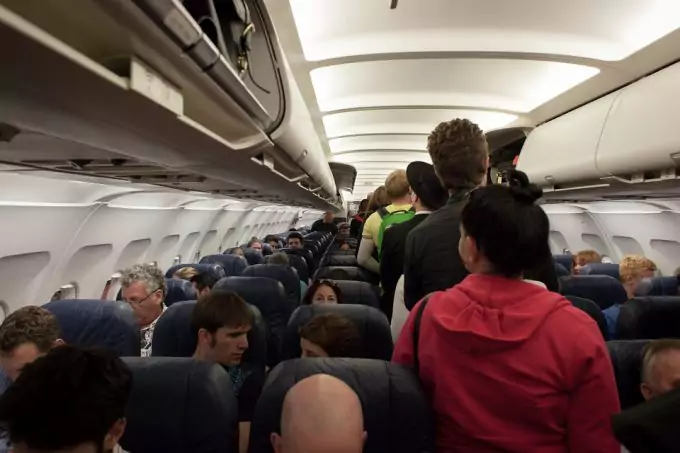
The best options for clothes are fabrics like cotton and wool. They have nice insulating properties, are natural products and less flammable. In fact, wool can be the ideal material for a safer flight – it can still remain a great insulator even if wet. This can be especially good in case the plane crashes in water.
While still on the topic of clothes and shoes, don’t wear uncomfortable shoes. This is important for business women who prefer to wear high heels. High heels aren’t allowed in a case of evacuation. This means you have to leave them behind, but that can be dangerous and expose you to shattered glass or other broken material. So, leave the high heels in your suitcase if you have business meetings after the landing, and wear comfortable and stable shoes.
Some people prefer snickers or even boots. While these can be a bit troublesome at some airport checks, they are a far safer option if you want to raise your chances of survival after a plane crash.
In the aircraft
This is when you need to decide where to sit. It has been estimated that seats at the back of the aircraft are much safer than those in front of it. Survival rates are in favor of the backseats’ passengers.
When it comes to strategic places, ideal are those close to the exit doors or the aisle. As much as it may be surprising it’s better to book economy-class tickets, than go for the first-class.
[the_ad_placement id=”in-text-2-type-r”]Before the flight, listen to the pre-flight instructions. Most people are bored by it, since they have heard it many times and hardly anyone listens, but you mustn’t follow the other passengers. Always pay attention to the safety speech and take a mental note on where the exits are. Take a good look at the aircraft and memorize the important points. Different airlines may have slightly different rules and after all planes aren’t always the same.
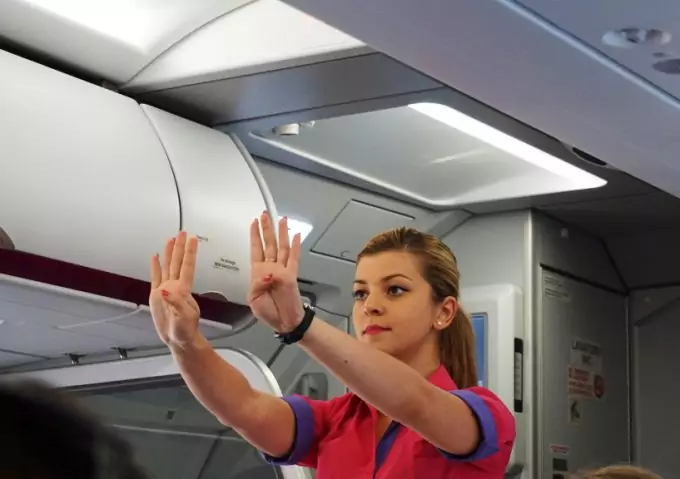
In case you’re close to or immediately next to the exit door, try to figure out how it can be opened. This is for you to assess the airplane before anything extreme or urgent happens. Take a look at the exit door and read any instruction which may be written on a sticker next to it. Memorize and imagine how that could work. This will give you a head start if you need to make an immediate reaction. After all, in an emergency situation if the flight attendants are injured or even dead, it will be you next to the exit door, that must open it.
Furthermore, if you’re not really that close to the exit door, before the flight, count how many seats are between you and the exit door. You can even write the number down to memorize it better. This will prepare you in the case when there’s low visibility due to smoke or you can’t see much because of the chaos and panic among people.
The overall situation may be too overwhelming to stay that focused, but as long as you know the seats you can keep that number in your head and concentrate on only that, when you try to reach the exit door. All of this will be much easier in the case of an incident.
You have probably heard that you’re advised to keep the seatbelt on all the time. This is to ensure that if anything abrupt happens you will not be hurled around suddenly, but will be safe in your seat. Keep in mind also that, as long as your seat belt is tight enough, this will minimize the G-force on your body during the crash itself.
If the belt is loose with only a centimeter, count the G-force three times. This is an incredible force and can break ribs and even injure your internal organs. So, keep the belt reasonably tight and right above the pelvis, and not around your soft stomach.
Preparation for the impact
Now that the incident has happened and you have several minutes before the actual crash to act, here is what to brace for.
It’s time to get to know if you’ll be crashing in water or land. If you’re above a body of water, immediately prepare the life vest and put it on yourself. You will have to inflate it before you actually leave the plane. Also, if you have spare clothes or a jacket, put that on before you put the life vest. Staying in water before you find some debris on which to climb on may take some time, and getting cold and suffering hypothermia isn’t going to be helpful.
To be better prepared before you even get on the plane, take a look at the route the plane will take and if it goes above ocean, sea, rivers, large lakes, etc. and prepare accordingly.
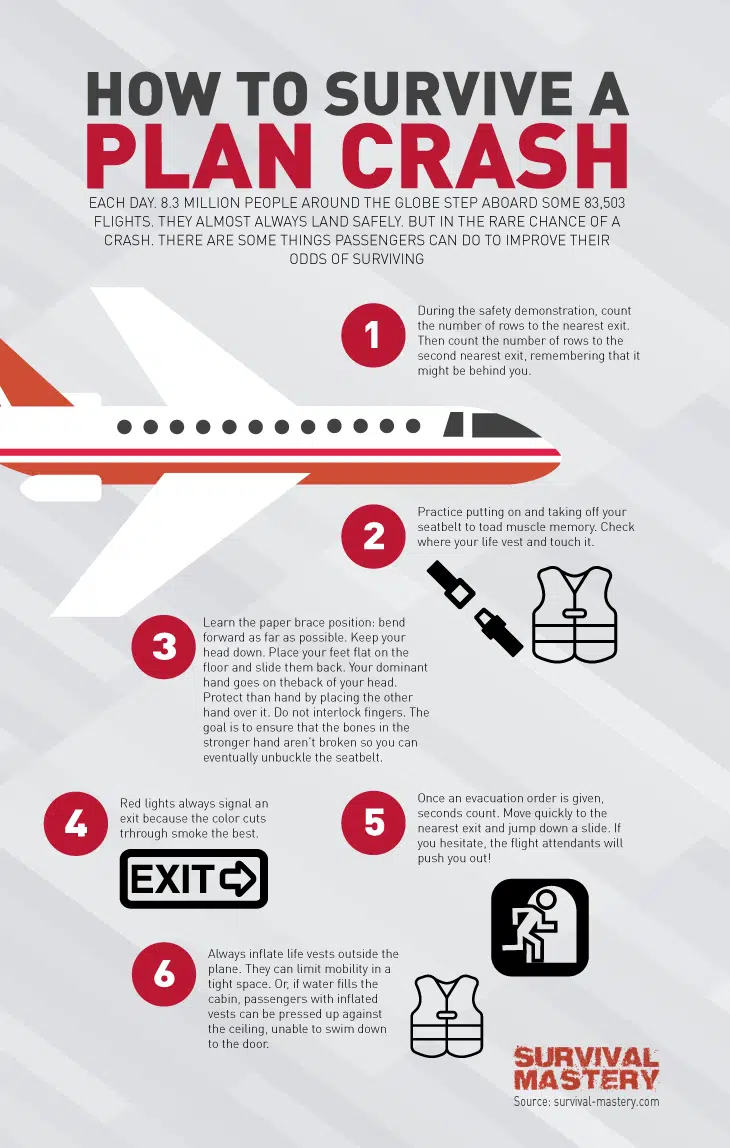
While still in the plane, before you lose control of the situation and people get too panicked and chaos sets in, assess the exits and if they are blocked and keep that in mind. If not, assess the route to the door and if there are any obstructions (fallen passengers’ bags, etc) and try to figure out how quickly you will get to the exit. Keep in mind that other people may rush to the exits too.
Minutes before the crash you should be still in your seat with your seat belt tightly fastened. You have to options for positioning yourself in your seat.
In the first option, you have to keep your legs tight to each other, and you have to bend ahead, with your head above or between your knees. Keep your hands clasped above your head for protection. Move your feet back so that you protect your shins and sliding bags can’t hit them accidentally.
Observe if you have loose shoe laces and tighten them. If you have flappy sides of your jacket, zip it. Keep anything loose or dangling from you, tight to your body. These can be dangerous and even hazardous items.
For the second position, you have the option to lean on the seat in front of you. Keep your legs again like in the previous position, tight and feet back. Lean ahead and rest your head on your two hands. Place your hands on the front seat and clasp one hand over the other. Your head should rest on your hands as if you sleep. A version of this position, is to keep your head on the front seat, but clasp your hands behind your head to protect it.
Of course, it is easy to advise you to keep calm no matter what. When your life is in danger you wouldn’t be really able to keep your calm and cool. Those people who actually are capable of remaining calm have undergone many training sessions and programs and know how to handle their own panic.
Most passengers haven’t been through any practical training and it is often the case that people panic and chaos reigns in. This, of course, doesn’t mean that we encourage you to panic, but on the contrary. The more contained and calm you are, the better your judgement will be. People rarely make the right decisions when under heavy stress and life-endangering situations, especially in those when you have little control.
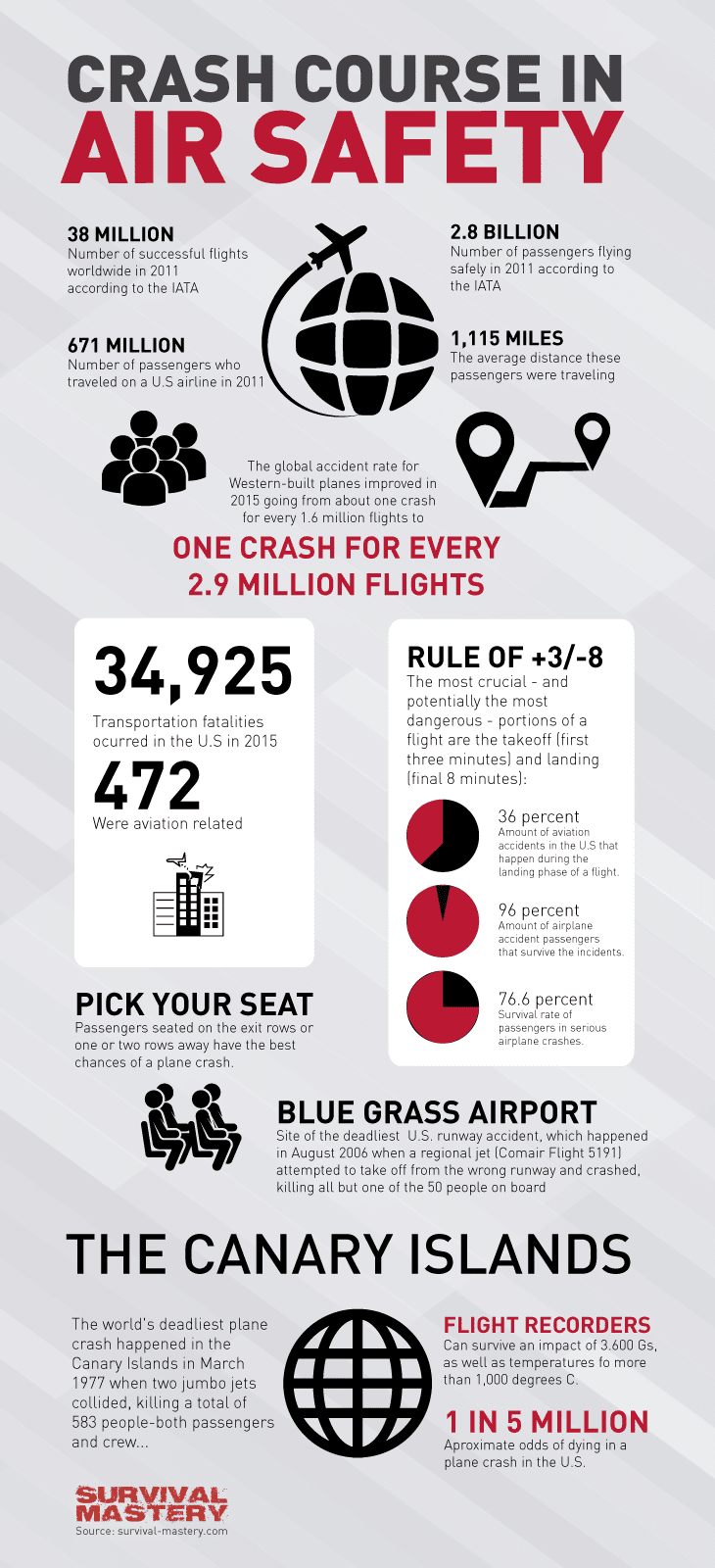
Remember that your main purpose is to remain alive after the crash. Your chances raise exponentially high the more calm and contained you are. If you practise in your mind the steps above, this can be like a mental preparation in case the worst happens.
Don’t let yourself be influenced by the other people’s panic, since panic will hardly help you at all.
Also, remember that you have to place your oxygen mask. Don’t try to help others before you do this step first to yourself. You can lose consciousness within seconds if you try to save the people around you. Even if you put the mask on your child, but have no time to place it on you, the child may survive, but if you lose consciousness, the child may not be able to help you because it will not know how to. This puts you at a far greater risk.
And of course, if someone is unconscious, you can still revive them if you place the mask within some reasonable amount of time.
After the crash and how to survive it
When the plane crashes there will be lots of fire and smoke in the aircraft. It has been estimated that most victims die of suffocation and poisoning from the dangerous chemicals of the burning aircraft and machinery. Quickly find a cloth to place on your mouth and nose to expose yourself as little as possible to the smoke. The best idea will be if you can have a wet cloth (if you had purchased a bottle of water and haven’t used it yet). It will block most particles from entering your lungs and mouth.
Also, try to crawl or at least stay lower than the thickest part of the smoke cloud. Remember that breathing the smoke fumes is the reason why so many people may die in the first minutes (or hours). As long as you can try and avoid breathing the most concentrated part of the smoke, you have higher chances and longer time to act.
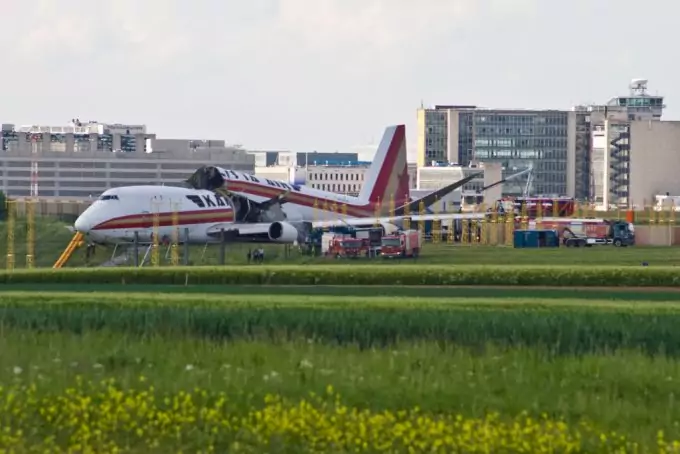
Your next step is of course, to exit the plane as soon as possible. It is unfortunate that most casualties of plane crashes are due to the fire and smoke and not because of injuries caused by the crash. This is why, the more the exit strategy is delayed the riskier it gets. This is when you have to remember where the exit door is and head to it immediately.
If possible, look through the window to assess where actually you have landed and if there may be something hazardous outside. Maybe you landed on a cliff, or there’s a roaring engine on fire, etc. Be aware of what is going on outside and plan ahead how to safely evacuate the passengers without endangering them further.
If the flight attendants are alive and can help you, try to listen to them and to follow what they instruct you. After all, they are also trained rigorously on the safety procedures after a plane crash and know how to evacuate the passengers efficiently without any fuss or panic. Your (and the other passengers’) chances of survival are much higher if you trust the flight attendants.
It has been often advised, but it hasn’t been applied by people that leaving your luggage is the best you can do. There are still people who would want to rescue their belongings. While it makes sense generally, it doesn’t when your life is in danger and it may only take a few minutes to make the right or the wrong decisions, thus the line between life and death is very thin. This is why, we strongly advise you to forget about any belongings you have, and exit the plane as quickly and safely as possible.
Think and focus only on saving your life. Your possessions can be restored as soon as you get back to civilization, but your life is only one.
After all, you can later salvage the plane for any valuable supplies, water, food, etc. after all the fire has gone out and there’s no more risk for your life. On thing you can use is some survival gear. Read our article on the benefits of wearing a paracord survival belt for more information.
After the exit
Once you’re out of the aircraft, try to keep a minimum distance of at least 500 feet/150m and head against the wind. Thus, in case of explosions, the wind won’t carry any leftover debris, heat, smoke towards you, but the other way.
[the_ad_placement id=”in-text-3-type-r”]In case you have crashed on a very small area, where you can’t safely move too far from the plane, try to be as far away from it. There is always the risk for explosions and fire and you don’t want to be anywhere near the plane.

After the crash, people are usually advised to stay calm and in one place. This increases their chances of being discovered. Also, try to tend to other people’s wounds, especially if they endanger their lives somehow. If anyone has a first-aid kit, use that, otherwise, use any items at hand to help someone’s bleeding. There is the chance that there may be a medical person who could help.
Also, don’t ignore your wounds thinking that they are insignificant. You may still be under the influence of adrenaline and still not feel the actual severity and pain of your injury. As long as you attend to yourself properly, you will be able to help others too. To learn the basics of treating cuts and wounds, see our article on this important topic.
So again, the final advice is to just stay put, since the crash spot has probably already been noted and the rescue teams are on their way. As long as you don’t go wandering around or too far away from the plane crash spot, you have a much higher chances of getting rescued.
Before you go to any trip, read our article on basic survival tips to keep you prepared for anything.




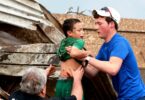

I still shudder every time I think of a plane crashing. It’s not that I’m afraid of heights, I’m just afraid of falling. The life jacket provided does have a whistle for emergencies and if you assess that there are only a few survivors do try to group together to increase the chances of survival. If you happen to fall on water and there are some unfortunate souls with you, if it’s not against your personal morals, you can take their life jackets and clothes and use it as your own. I mean, they’ve passed already and you have not. Your survival is more important.
Yes, this is a viable action in case you can’t survive otherwise.
Great article, David! I think it’s also important to avail of travel insurance. Most people, especially teenagers and adolescents these days, choose to exclude travel insurance to save money but it’s very helpful not only during the flight but also during the whole duration of a travel/vacation. Sometimes, airline companies only give limited assistance and remember that they’ll probably have to give them in hundreds of passengers, so it’s better to have a separate insurance company handle you. That said, ultimately we all wish you won’t need that insurance but better prepared than sorry.
Hi Barbara,
The chances of surviving a plane crash are already good, but a few tips can help you beat the odds.